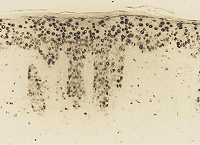![anti-8-Hydroxy-2-deoxyguanosine [8-OHdG], mAb (N45.1) anti-8-Hydroxy-2-deoxyguanosine [8-OHdG], mAb (N45.1)](https://adipogen.com/pub/media/catalog/product/j/a/jai-mog-ihc-8ohdg_stain_3.jpg)
anti-8-Hydroxy-2-deoxyguanosine [8-OHdG], mAb (N45.1)
JAI-MOG-100P
ApplicationsELISA, ImmunoHistoChemistry
Product group Antibodies
Overview
- SupplierJaICA
- Product Nameanti-8-Hydroxy-2-deoxyguanosine [8-OHdG], mAb (N45.1)
- Delivery Days Customer10
- ApplicationsELISA, ImmunoHistoChemistry
- CertificationResearch Use Only
- ClonalityMonoclonal
- Clone IDN45.1
- HostMouse
- IsotypeIgG1
- Scientific Description8-hydroxy-2-deoxyguanosine (8-OHdG) is a modified base that occurs in DNA due to attack by hydroxyl radicals (incl. singlet oxygen and direct photodynamic action) that are formed as byproducts and intermediates of aerobic metabolism and during oxidative stress. There is increasing evidence to support the involvement of free radical reactions in the damage of biomolecules that eventually lead to several diseases in humans, such as atherosclerosis, cerebral and heart ischemia-reperfusion injury, cancer, rheumatoid arthritis, inflammation, diabetes, aging, and neurodegenerative conditions, such as Alzheimers disease. 8-OHdG is popular as a sensitive, stable and integral marker of oxidative damage in cellular DNA and can be detected in tissue, serum, urine and other biomaterials. - Monoclonal Antibody. Recognizes 8-OHdG. Does not cross-react with 19 analogues of 8-OHdG (guanosine (G), 7-methylG, 6-SHG, 8-bromoG, dA, dC, dT, dI, dU, dG, O6-methyldG, 8-OHdA, guanine (Gua), O6-methylGua, 8-OHGua, uric acid, urea, creatine, creatinine). Minimal cross-reactivity with 8-sulfhydrylG and 8-OHG (less than 1%). Lyophilized. Contains 10mM PBS, pH7.4 containing 1.0% BSA. 8-hydroxy-2-deoxyguanosine (8-OHdG) is a modified base that occurs in DNA due to attack by hydroxyl radicals (incl. singlet oxygen and direct photodynamic action) that are formed as byproducts and intermediates of aerobic metabolism and during oxidative stress. There is increasing evidence to support the involvement of free radical reactions in the damage of biomolecules that eventually lead to several diseases in humans, such as atherosclerosis, cerebral and heart ischemia-reperfusion injury, cancer, rheumatoid arthritis, inflammation, diabetes, aging, and neurodegenerative conditions, such as Alzheimers disease. 8-OHdG is popular as a sensitive, stable and integral marker of oxidative damage in cellular DNA and can be detected in tissue, serum, urine and other biomaterials.
- Storage Instruction-20°C,2°C to 8°C
- UNSPSC12352203

